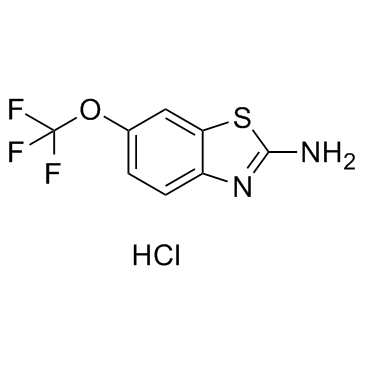850608-87-6
| Name | Riluzole (hydrochloride) |
|---|---|
| Synonyms |
6-(Trifluoromethoxy)-1,3-benzothiazol-2-amine hydrochloride (1:1)
2-Benzothiazolamine, 6-(trifluoromethoxy)-, hydrochloride (1:1) Riluzole HCl Riluzole hydrochloride |
| Description | Riluzole hydrochloride is an anticonvulsant drug and belongs to the family of use-dependent Na+ channel blocker which can also inhibit GABA uptake with an IC50 of 43 μM. |
|---|---|
| Related Catalog | |
| Target |
Sodium channel[1] IC50: 43 μM (GABA receptor)[1] |
| In Vitro | Riluzole hydrochloride is an anticonvulsant drug and belongs to the family of use-dependent Na+ channel blocker which can also inhibit GABA uptake with an IC50 of 43 μM. At 20 μM, Riluzole hydrochloride inhibits peak autaptic IPSCs only slightly but prolongs IPSCs reliably. It is also found that Riluzole hydrochloride causes a strong, concentration-dependent, readily reversible enhancement of responses to 2 μM GABA. At higher concentrations of Riluzole hydrochloride, especially 300 μM, GABA currents exhibit apparent desensitization during prolonged co-exposure to 2 μM GABA and Riluzole hydrochloride. The EC50 of Riluzole hydrochloride potentiation of GABA responses is about 60 μM[1]. |
| In Vivo | In normal naïve rats, systemic injection of Riluzole hydrochloride (8 mg/kg, i.p.; n=6 rats) decreases the duration of ultrasonic but not audible vocalizations evoked by noxious stimulation of the knee joint compare to vehicle tested in the same rats (P<0.05). Systemic application of Riluzole hydrochloride (8 mg/kg, i.p.; n=19 rats) decreases the vocalizations of arthritic rats compare to predrug and vehicle significantly (P<0.05 to 0.001). Riluzole hydrochloride administered into the CeA significantly decreases the duration of audible and ultrasonic vocalizations evoked by noxious stimulation of the knee compare to predrug values (n=8 rats; P<0.05 to 0.01)[2]. |
| Cell Assay | Two-electrode voltage clamp of Xenopus oocytes expressing exogenous GABAA receptors is performed with a CA-1B high performance oocyte clamp. The extracellular recording solution is ND-96 medium. Riluzole hydrochloride is applied from a common tip via a gravity-driven multibarrel drug-delivery system. Data acquisition and analysis are performed with pCLAMP 6 software[1]. |
| Animal Admin | Adult male Sprague-Dawley rats (180 to 350 g) are housed in a temperature-controlled room and maintained on a 12-h day/night cycle with unrestricted access to food and water. Pain behaviors are measured before and 5 h after induction of a mono-arthritis in the left knee joint. To test the effects of systemic (intraperitoneal, i.p.) application of Riluzole hydrochloride, pain behaviors are measured 1 h postinjection of Riluzole hydrochloride in normal and arthritic animals. To determine effects of Riluzole hydrochloride into the amygdala, pain behaviors are measured 15 min after starting Riluzole hydrochloride application through a stereotaxically implanted microdialysis probe. To investigate site of action in the amygdala of systemically applied Riluzole hydrochloride, potassium channel blockers are administered into the amygdala 45 min after systemic application of Riluzole hydrochloride and pain behaviors are measured 15 min later, i.e., 1 h postinjection of riluzole (i.p.)[2]. |
| References |
| Molecular Formula | C8H6ClF3N2OS |
|---|---|
| Molecular Weight | 270.659 |
| Exact Mass | 269.984131 |
| PSA | 76.38000 |
| LogP | 4.16030 |
| Storage condition | 2-8℃ |
